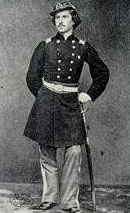
Elmer Ephraim Ellsworth (1837-1861)
Elmer E. Ellsworth (April 11, 1837 - May 24, 1861), born near Saratoga Springs, N.Y., left home and went to New York City at an early age. He then moved to Chicago, Ill., where he worked as a law clerk, became interested in military science, and joined Chicago's National Guard Cadets. Made colonel of the group, Ellsworth infused the unit with his enthusiasm. He introduced his men to the flashy Zouave uniforms and drill that emulated French colonial troops in Algeria and turned the group, renamed the U.S. Zouave Cadets, into a national champion drill team. In the summer of 1860, the unit performed hundreds of quick, flashy movements with their muskets and bayonets for awed audiences in 20 cities. 
In August Ellsworth went to Springfield, Ill., to study law in Abraham Lincoln's office. He helped Lincoln with his campaign for president and went with him to Washington, D.C. Lincoln called Ellsworth "the greatest little man I ever met." When the Civil War erupted, Ellsworth went to New York City and raised a regiment of volunteers from the city's firefighters.
As colonel of the New York Fire Zouaves, Ellsworth was anxious to be the first to invade the South. On May 24, 1861, the day after Virginia seceded, Ellsworth led his men uncontested down the streets of Alexandria. He sent some of his men to take the railroad station while he and a few others went to secure the telegraph office. On the way he noticed a Confederate flag atop the Marshall House Inn. Ellsworth and four others quickly ascended the stairs; Ellsworth cut down the flag and was on the way down the stairs when the proprietor killed him with a shotgun blast to the chest. Cpl. Francis Brownell immediately killed the innkeeper.
Lincoln, grief-stricken, had an honor guard bring his friend's body to the White House, where it lay in state on May 25. The body was then moved to City Hall in New York City, where thousands paid their respects to the first man to fall for the Union. Ellsworth was buried in Mechanicville, N.Y.
From the United States Civil War site.